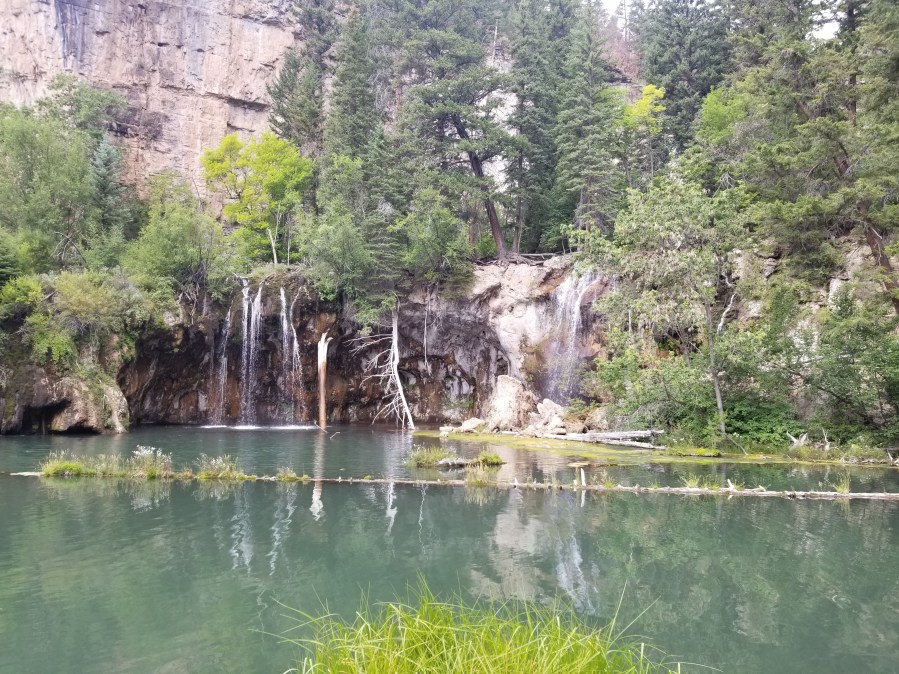GLENWOOD SPRINGS, Colo. — Hanging Lake remains closed to the public, but FOX31 crews were invited for a special tour of the trail to show its condition following mudslides in July.
U.S. Forest Service officials say Hanging Lake will be closed through 2021 and likely beyond. Mudslides and historic rains through the Grizzly Creek burn scar caused major damage to the trail.
“There’s a lot of interest in Hanging Lake. This is an iconic location in Colorado so we just want people to see what it looks like,” David Boyd with the White River National Forest said.
Hanging Lake trail damage ‘unsafe’
The first sign of significant damage comes right at the Hanging Lake trailhead. Two picnic tables and the picnic area are buried in mud. Plus, the area underneath a bridge leading to the restrooms is clogged with debris.
Once hikers begin the trail, for the first several minutes it remains relatively similar to what it was like in the past. The trail follows a series of steep, rocky steps toward the first bridge crossing the creek.
Bridge No. 1 is “totally warped, twisted. It’s knocked off its foundation,” Eagle-Holy Cross District Ranger Leanne Veldhuis said.
The structure is not only partially covered in mud but also unsecured from its foundation. Traversing it requires extreme caution, and hikers must step over the handrail to regain the trail.
Bridge No. 1 is one of the primary reasons the trail remains closed to the public. It is unsafe, and there are no easy fixes or simple alternate routes.

“This is the second-worst bridge. The worst bridge has been blown down the creek about 200 feet,” Veldhuis said.
Bridge No. 2 no longer exists on the trail, and it is nearly impossible to tell where it used to stand. Instead, hikers must descend rocks and mud and cross the creek bed on foot.
The next part of the trail is buried under up to 10 feet of debris, including rocks, mud and trees. It is easy to lose sight of the path and potentially dangerous because of shifting talus fields.
Past the final bridge, hikers have a clear path to the steps leading up to Hanging Lake. The boardwalk and overlooks remain intact.
“It’s not like it was before the slides. It’s still a little cloudy, but you can look in and see the fish,” Boyd said.
When will the Hanging Lake trail be ready for hikers again?
While the lake begins to heal itself and filter out the mud, it will take much more work to get the trail back to working order.
“We’re looking at a longer-term solution that would be a new trail that would be sustainable for many years. That’s gonna take a few years to get in place probably,” Boyd said.
Forest officials will need to assess the damage and design a new trail to withstand future weather events. That could include rerouting the trail in some spots and rebuilding bridges.
There is no estimate on when the work will be completed. Part of the reason for the extended trail closure and repair timeframe hinges on the fact that most of the debris removal and restoration work must be done by hand. It is not possible to bring heavy machinery into most trail areas.
“And in the meantime, we’re looking at if there’s a short-term solution that might be more of a primitive hike,” Boyd said.
The primitive hike would likely include stream crossings and difficult hiking through debris fields. It is expected to be more difficult for hikers than the previous maintained trail.
“We don’t know for sure. But it will not be the same experience as a very well engineered, developed trail,” Boyd said.
While the closure and damage will no doubt be disappointing to those hoping to hike Hanging Lake, Boyd, Veldhuis and the rest of the team say it is a unique chance to rebuild the trail to withstand increased traffic and extend its life for many more decades.
“We’re working really hard to make sure that it’s gonna be open again for people to enjoy it, but we want to do it in a way that’s sustainable and that it’s safe for people to get up there,” Boyd said.
